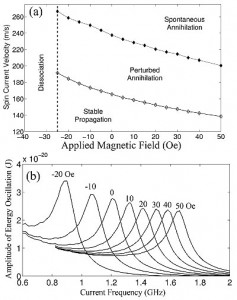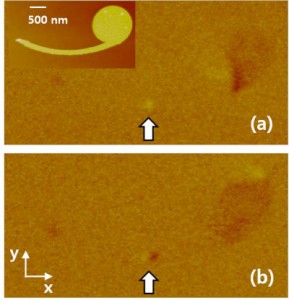360-degree Magnetic Domain Walls
- Category: Nanotechnology
- Tags: Caroline Ross, Mark Mascaro
Many domain wall (DW) devices require the presence of multiple DWs, each of which may need to be independently controlled and moved. As a result, we are investigating the interaction of domain walls in a single ferromagnetic nanowire. In particular, we are focusing on 360o domain walls (360 DWs) in which the magnetization makes a full in-plane 360° turn in a localized region of the stripe, while the rest of the stripe is magnetized parallel to its edges.
Applied current, utilizing the spin-torque effect, is the most promising method for driving domain wall devices. Our simulations indicate that 360 DWs have a response to a current that is qualitatively different from the behavior of the constituent 180 DWs. The 360 DWs move at a velocity independent of applied magnetic fields and can be destroyed by a burst of applied current. The stability of the domain wall can be controlled by an externally applied field, as shown in Figure 1. These features make the 360 DW a potential candidate as a data token in novel domain wall logic devices. Additionally, we have observed and are currently investigating resonant behavior in the 360 DW, which can be tuned by an applied field, as in Figure 1(b)). Simultaneously, we experimentally demonstrate the controlled generation of 360 DWs in rings and in a nanostructure consisting of a circular pad attached to a curved wire, as shown in Figure 2. The response of a 360 DW to current is being characterized using anisotropic magnetoresistance.
- Figure 1: (a) Regimes of behavior of a 360 DW in the presence of a current and an applied field. In the “spontaneous annihilation” regime, the wall is destroyed by the current. An applied field increases or decreases the annihilation current and thus the maximum velocity of the wall. (b) Resonant behavior of a 360° DW pumped by high-frequency current. Modest applied fields from -20 to 50 Oe shift the resonant frequency from 0.8 to 1.7 GHz.
- Figure 2: (a) Magnetic force microscopy (MFM) image after saturation at 5000 Oe, showing generation of a 180 DW. (b) MFM image of 360 DW after injection of second 180 DW. The inset is an atomic force microscopy image of Co (6 nm) nanostructure.
- M. D. Mascaro, C. Nam, and C. A. Ross, “Interactions between 180 and 360 degree domain walls in magnetic multilayer stripes,” Appl. Phys. Letts. Vol. 96, no. 162501, pp. 1-3, 2010.
- C. Nam, M. D. Mascaro, and C. A. Ross, “Magnetostatic control of vortex chirality in Co thin film rings,” Appl. Phys. Lett., vol. 96, no. 012505, pp. 1-3, 2010.
- M. D. Mascaro and C.A. Ross, “AC and DC Current-Induced Motion of a 360˚ Domain Wall,” Phys. Rev. B vol. 82, p. 214411, 2010.

